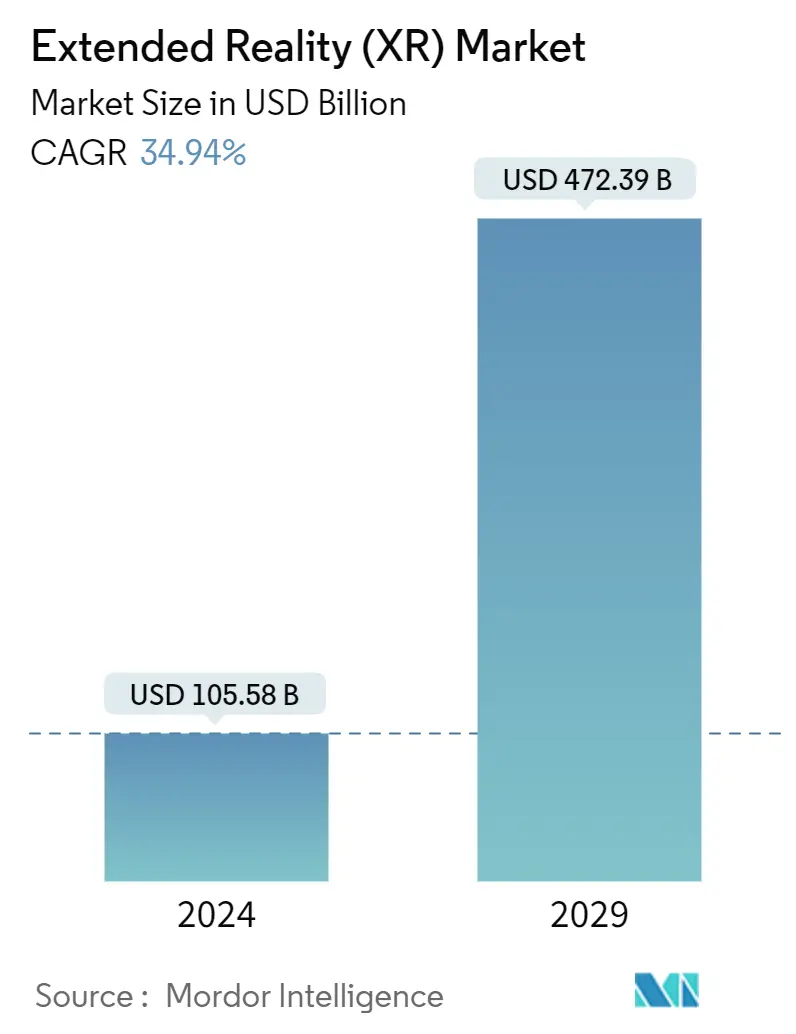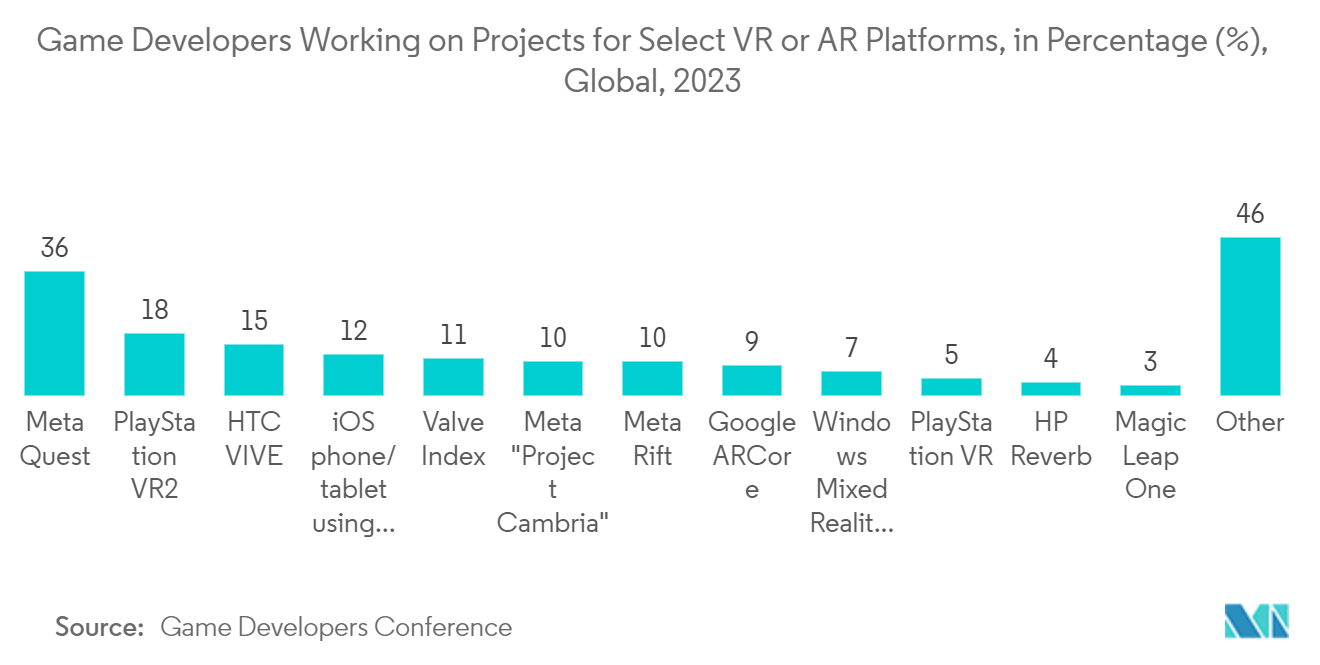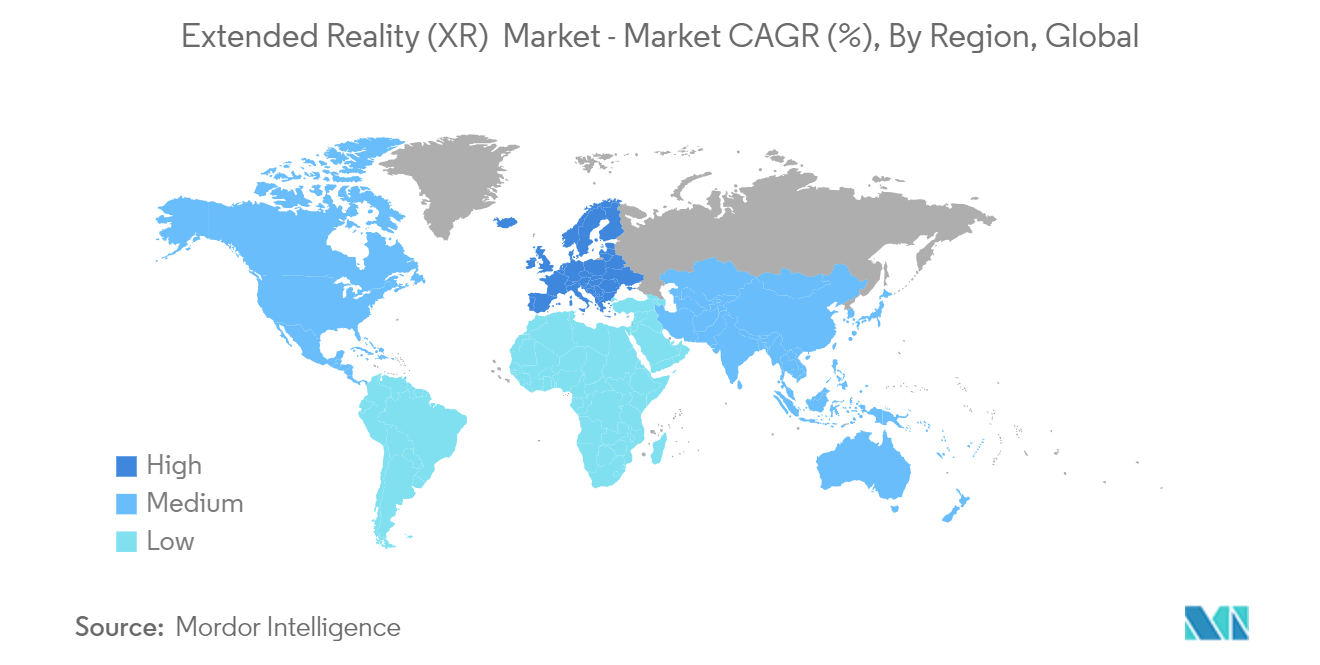Extended Reality (XR) Market Size

| Study Period | 2019 - 2029 |
| Market Size (2024) | USD 105.58 Billion |
| Market Size (2029) | USD 472.39 Billion |
| CAGR (2024 - 2029) | 34.94 % |
| Fastest Growing Market | Europe |
| Largest Market | North America |
Major Players_Market_Major_Players_Logo.webp)
*Disclaimer: Major Players sorted in no particular order |
Need a report that reflects how COVID-19 has impacted this market and its growth?
Extended Reality (XR) Market Analysis
The Extended Reality Market size is estimated at USD 105.58 billion in 2024, and is expected to reach USD 472.39 billion by 2029, growing at a CAGR of 34.94% during the forecast period (2024-2029).
Extended reality is a new umbrella term for immersive technology, including Augmented Reality, Virtual Reality, and Mixed Reality, which will include additional future realities expected to be created by these technologies. Increased demand for shorter distances among individuals and improved visual information are the main drivers of market need.
- The idea of live virtual entertainment is spreading all over the world. People prefer at-home entertainment using technologies to attend live shows or events. The demand for Live Concerts, Live Shows, and Sports has grown substantially due to technologies enabling consumers to experience the real world interactively.
- In addition, the market is expected to grow over the forecast period, due to by increased adoption of gesture computing, a trend in miniaturization for intelligent devices, technological progress, and different growth strategies implemented by companies.
- With the advancement of miniaturization and smart technology, sensors and electronic systems that could be incorporated into a person's body will continue to shrink. Smart devices and many other Internet of Things applications drive the miniaturization trend.
- Training a more extensive audience is one of the biggest problems with XR technology. Existing development applications are restricted to a single user for tablets, smartphones, and wearables. Multi-XR user experiences, consistent and simplified, need to be developed to be more accessible. In the current market scenario, there is a need for more availability of these solutions, which significantly negatively impacts industry growth.
- Due to COVID-19 and the rising concerns about worker safety, many organizations have switched to remote working using the cloud. This is the primary motivator behind the need for XR, which allows people to work efficiently from home, join virtual meetings, and visualize a business atmosphere.
Extended Reality (XR) Market Trends
Media and Entertainment End User Segment Holds Significant Market Share
- Media companies have explored the possibility of using XR technology as a new way to tell stories and as an advertising outlet for several years. They've been working in partnership with companies that create virtual reality headsets and software developers who are broadcasting VR events so they can determine the best ways to build content for Virtual Reality. In addition, investment in VR firms has begun to be made by some companies.
- The ability to engage with customers, which allows companies to create emotional links between products and services, constitutes the most significant marketing potential of the XR. Media companies could benefit from the efficiency of XRPowered Technology in reaching their target audience. XR applications allow a customer's experience to be played out in real life, increasing interactivity, engagement, and appeal. This makes it possible for digital agencies and buyers of media to feel emotionally attached to their brands.
- Virtual reality allows fans to watch live sports and choose viewing angles so that they can see them up close. With this immersive experience, viewers can virtually sit in their favorite stadium seats. XR also allows fans to view data and analyses of the games that are currently in progress or have already been played at any time. Virtual reality and alternative reality gaming are more visions of the future in the gaming world. According to the Game Developers Conference 2023, 36% of responding game developers globally are actively developing games for the Meta Quest virtual reality headset.
- The growth of expanded reality in both media and entertainment is supported by a number of factors, e.g., 5G's implementation and adoption, access to technically feasible hardware at reasonable costs, and technology maturity. With the advent of Time Critical Communication using 5G networks, it is possible to reduce parts of XR's processing and function in the edge cloud and improve user experiences by making head-mounted displays lighter and more cost-effective.

North America Holds Largest Market Share
- Given the considerable investments made by several companies in market innovation, the North American region for an extended reality market will be significantly growing over the forecast period.
- The United States is one of the world's largest markets for highly innovative virtual reality, AR, VR, and mixed reality, MR. The United States is the home country of many companies working on this technology. The region is very firmly in demand because of its high exposure to technology and the ease with which connected devices are operated. Users nationwide have responded positively to Microsoft's augmented reality, Hololens, first available in the United States and Canada.
- There is also the expectation that this region will hold a significant market share. The US government has developed direct and indirect ways of using these technologies to assist innovation and foster prosperity. In addition, virtual reality has been introduced as an educational tool for specific training by the State Department's Foreign Service Institute. Moreover, various AR and VR training programs have been implemented to develop local workforces and manage wastewater. The region will also dominate the market due to its rich technical potential and easy availability of resources, which have led to a strong demand for advanced reality devices. Innovative technology is being deployed by many regional businesses for AR and VR wearable devices.
- As a way of attracting new customers to the use of their 5G network, regional telecommunications operators are also working hard. Therefore, by exploiting the forthcoming 5G technology, these regional providers are investing and innovating in software and platforms to develop AR applications.

Extended Reality (XR) Industry Overview
The extended reality (XR) market is highly fragmented with the presence of major players like Qualcomm Technologies Inc., Accenture PLC, SoftServe Inc., SphereGen Technologies LLC, and Northern Digital Inc. Players in the market are adopting strategies such as partnerships, innovations, investments, mergers, and acquisitions to enhance their product offerings and gain sustainable competitive advantage.
In January 2023, Sphere, previously known as holo|one, announced the introduction of its newest software, which includes features expected to transform the game into extended reality (XR). This announcement puts the firm as the first to fully realize the possibilities of immersive cooperation by merging the power of XR with cutting-edge translation technology.
In December 2022, Accenture invested through Accenture Ventures in BehaVR, one of the leading innovators in virtual reality (VR) digital therapeutics experiences and digital wellness, and d. The merger with Oxford and the spin-out of OXFORD University, a VR leader in science-based Virtual Reality treatments for severe mental illness, have also been announced by BehaVR.
Extended Reality (XR) Market Leaders
Qualcomm Technologies Inc.
Accenture PLC
Northern Digital Inc.
SoftServe Inc.
SphereGen Technologies LLC
*Disclaimer: Major Players sorted in no particular order
_Market_competive_logog1.webp)
Extended Reality (XR) Market News
- January 2023: CYENS announced the XR4ED Extended Reality for Education project launch. The XR4ED program is aimed at immersive technologies and brings together a diverse group of stakeholders working in the increasingly emerging field of extended reality.
- January 2023: Mapstar, the XR Map-based Metaverse that allows users to easily create new digital realities by mapping the environment in 3D and anchoring digital assets, unveiled its Augmented Reality on-site editing, LiDAR, XR-layer, and VR capability to enhance the retail shopping experience for visitors of shopping malls.
Extended Reality (XR) Market Report - Table of Contents
1. INTRODUCTION
1.1 Study Assumptions and Market Definition
1.2 Scope of the Study
2. RESEARCH METHODOLOGY
3. EXECUTIVE SUMMARY
4. MARKET INSIGHTS
4.1 Market Overview
4.2 Industry Attractiveness - Porter Five Forces
4.2.1 Bargaining Power of Suppliers
4.2.2 Bargaining Power of Consumers
4.2.3 Threat of New Entrants
4.2.4 Threat of Substitute Products
4.2.5 Intensity of Competitive Rivalry
4.3 Technology Snapshot
4.4 Impact of COVID-19 on the Market
5. MARKET DYNAMICS
5.1 Market Drivers
5.1.1 Increasing Adoption of Gesture-Based Computing
5.1.2 Growing Trend of Miniaturization in Smart Devices
5.2 Market Restraints
5.2.1 Complexity in the Implementation Process in Terms of Technology and Cost
5.2.2 Vulnerability for Cyber Attacks, along with the High Cost of Implementation
6. MARKET SEGMENTATION
6.1 By Solution
6.1.1 Consumer Engagement
6.1.2 Business Engagement
6.2 By Application
6.2.1 Virtual Reality (VR)
6.2.2 Augmented Reality (AR)
6.2.3 Mixed Reality (MR)
6.3 By End-user Industry
6.3.1 Education
6.3.2 Retail
6.3.3 Industrial and Manufacturing
6.3.4 Healthcare
6.3.5 Media and Entertainment
6.3.6 Other End-user Industries
6.4 By Geography
6.4.1 North America
6.4.2 Europe
6.4.3 Asia Pacific
6.4.4 Rest of the World
7. COMPETITIVE LANDSCAPE
7.1 Company Profiles*
7.1.1 Qualcomm Technologies Inc.
7.1.2 Accenture PLC
7.1.3 SoftServe Inc.
7.1.4 SphereGen Technologies LLC
7.1.5 Northern Digital Inc.
7.1.6 Microsoft Corporation
7.1.7 Softweb Solutions Inc. (Avnet Inc.)
7.1.8 Tata Elxsi Limited
7.1.9 Varjo Technologies Oy
7.1.10 Talespin Reality Labs Inc.
8. INVESTMENT ANALYSIS
9. FUTURE OF THE MARKET
Extended Reality (XR) Industry Segmentation
Extended reality (XR) is an umbrella term encompassing augmented and virtual reality, covering a full spectrum of real and virtual environments. XR experience also caters to business issues and creates innovative solutions to increase efficiency and productivity to meet critical client needs. Implementing XR provides enterprises a platform that helps people perform their jobs more effectively.
The Extended Reality (XR) Market is segmented by solution (consumer engagement and business engagement), application (virtual reality (VR), augmented reality (AR), and mixed reality (MR)), end-user industry (education, retail, industrial and manufacturing, healthcare, media and entertainment, and other end users), and geography (North America, Europe, Asia Pacific, and Rest of the World). The market sizes and forecasts are provided in terms of value in USD for all the above segments.
| By Solution | |
| Consumer Engagement | |
| Business Engagement |
| By Application | |
| Virtual Reality (VR) | |
| Augmented Reality (AR) | |
| Mixed Reality (MR) |
| By End-user Industry | |
| Education | |
| Retail | |
| Industrial and Manufacturing | |
| Healthcare | |
| Media and Entertainment | |
| Other End-user Industries |
| By Geography | |
| North America | |
| Europe | |
| Asia Pacific | |
| Rest of the World |
Extended Reality (XR) Market Research FAQs
How big is the Extended Reality (XR) Market?
The Extended Reality (XR) Market size is expected to reach USD 105.58 billion in 2024 and grow at a CAGR of 34.94% to reach USD 472.39 billion by 2029.
What is the current Extended Reality (XR) Market size?
In 2024, the Extended Reality (XR) Market size is expected to reach USD 105.58 billion.
Who are the key players in Extended Reality (XR) Market?
Qualcomm Technologies Inc., Accenture PLC, Northern Digital Inc., SoftServe Inc. and SphereGen Technologies LLC are the major companies operating in the Extended Reality (XR) Market.
Which is the fastest growing region in Extended Reality (XR) Market?
Europe is estimated to grow at the highest CAGR over the forecast period (2024-2029).
Which region has the biggest share in Extended Reality (XR) Market?
In 2024, the North America accounts for the largest market share in Extended Reality (XR) Market.
What years does this Extended Reality (XR) Market cover, and what was the market size in 2023?
In 2023, the Extended Reality (XR) Market size was estimated at USD 68.69 billion. The report covers the Extended Reality (XR) Market historical market size for years: 2019, 2020, 2021, 2022 and 2023. The report also forecasts the Extended Reality (XR) Market size for years: 2024, 2025, 2026, 2027, 2028 and 2029.
What are the major challenges for Extended Reality (XR) adoption?
The major challenges for the Extended Reality (XR) adoption are: a) High costs of devices b) Limited content library c) Technical limitations affecting user experience d) Concerns over privacy and data security
XR Industry Report
The Extended Reality (XR) market is witnessing remarkable growth, propelled by the widespread adoption of Augmented Reality (AR), Virtual Reality (VR), and Mixed Reality (MR) technologies across diverse sectors. This surge is attributed to advancements in internet connectivity, the spread of mobile and PC-tethered XR devices, and the advent of 5G technology. Key industries like healthcare, entertainment, gaming, automotive, and education are embracing XR for its revolutionary applications in training, patient care, and immersive experiences. The demand in retail and e-commerce for enhanced customer engagement is also soaring. Geographically, the Asia-Pacific region leads in market growth, with North America and Europe closely following, driven by 5G deployment and affordable VR devices. Continuous innovations in XR software and hardware are opening new avenues for engaging with digital content. For detailed statistics, market share, size, and revenue growth insights, Mordor Intelligence™ Industry Reports offer a comprehensive analysis and forecast outlook, available as a free report PDF download.
